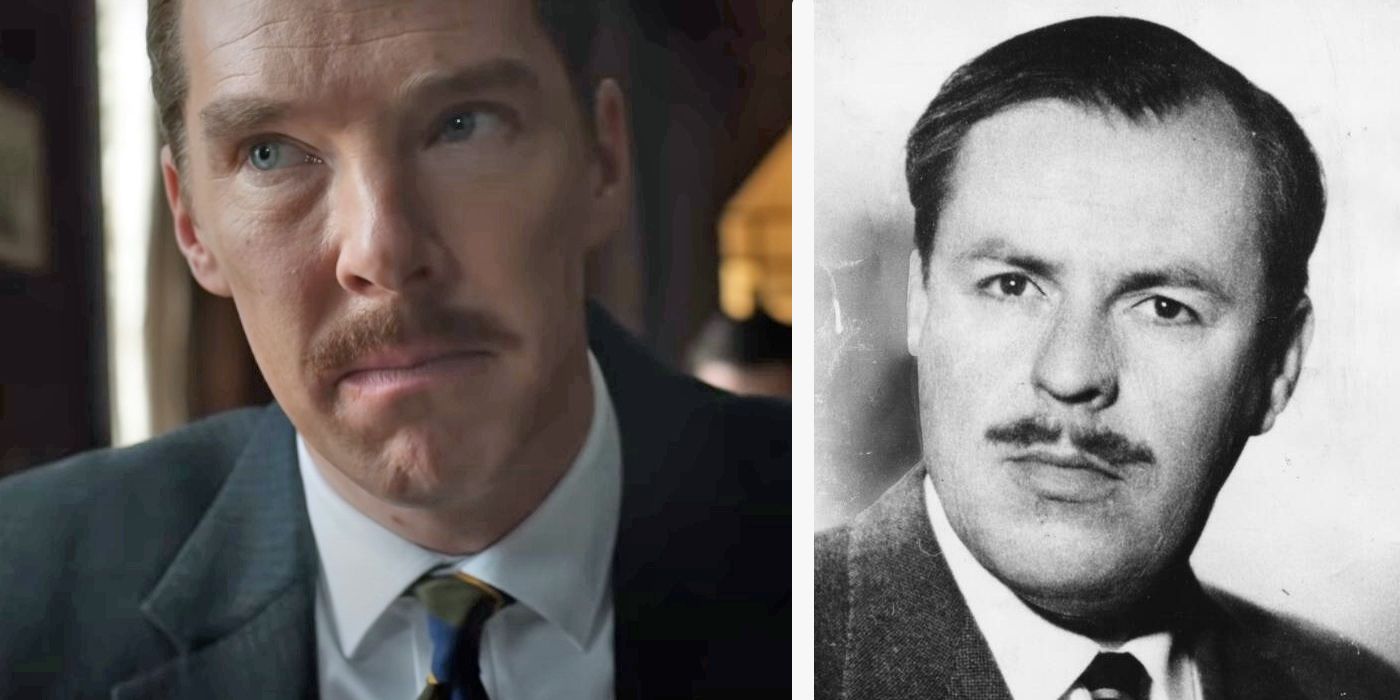The historical Cold War-era drama The Courier is based on the true story of Greville Wynne, a British businessman who became an unlikely MI6 agent in the early 1960s. The film premiered at the Sundance Film Festival in January 2020, and began streaming on Amazon Prime Video in 2021 after a short theatrical release. Inspired by the extraordinary efforts of an ordinary man, Tom O’Connor wrote the script. Directed by Dominic Cooke, The Courier stars Benedict Cumberbatch (Dr. Strange) as Greville Wynne and Merab Ninidze as Soviet intelligence officer Oleg Penkovsky. Here’s the answer to “is The Courier a true story?”.
The film begins in the early 1960s, when Penkovsky, a high-ranking member of the Soviet’s GRU agency, uses American students to deliver a message to the United States about nuclear operations in the Soviet Union. In the letter, he also shares his desire to defect from the Soviet Union and agreed to pass along top secret information from the government. Starting with his recruitment to join MI6, The Courier follows Greville Wynne as he forges an unlikely friendship with Penkovsky and becomes an unexpected spy for the British and American intelligence agencies.
In passing along the information stolen by Penkovsky, the two men played a role in deterring an all-out nuclear war. How Penkovsky and Wynne did it, how they were caught, and what happened to them next is the focus of The Courier. Examining this moment in Cold War Era history, the film does a good job of remaining historically accurate with a few minor adjustments for dramatic effect. But in condensing the content into a two-hour feature, there are also a lot of details of the true story that get left out. Here’s an answer to the question, “is The Courier a true story?”, the information missing from the movie about how this historical endeavor played out, and the way a Soviet intelligence officer and an average, everyday British citizen succeeded in helping to stop a nuclear war.
Cold War History & The Cuban-Missile Crisis
To answer the question “is The Courier a true story?”, one need only to look back in history. Referred to as The Cuban Missile Crisis in the U.S. during the Cold War, this real-life confrontation between America and the Soviets is considered the closest the two countries came to potentially starting World War III during the Cold War era. While it was one of the most important events of that time, the entire incident occurred over less than five years. In contrast, the decades-long period of geopolitical tension between the two countries and their respective allies lasted much longer, from the end of World War II until the Dissolution of the Soviet Union in December of 1991.
The Real Greville Wynne & MI6 Recruitment
In the film, Greville Wynne is recruited by MI6 operative Dickie Franks (Angus Wright), and Emily Donovan of the CIA (played by The Marvelous Mrs. Maisel star, Rachel Brosnahan). Dickie Franks is based on a real person. According to The Smithsonian Magazine, in November 1960, Franks recruited Wynne during what he thought was a business dinner – much like the scene depicted in The Courier. At the time, Wynne was an industrial sales consultant, and MI6 recruited him because of his previous trips to countries controlled by the Soviet Union, giving him the perfect cover for his mission to Moscow. The film closely follows the true story from there, with Wynne befriending Penkovsky, who photographs Soviet military documents, which Wynne passes along to his handler, Franks.
While The Courier’s Dickie Franks was based on a real person, according to USA Today, CIA agent, Emily Donovan was created as a composite character inspired by several real-life people involved in the intelligence operation. Including Janet Chisholm, who was the wife of a British officer stationed in Moscow who reportedly served as one of Penkovsky’s handlers there. Unlike in the film, MI6 didn’t immediately turn over the information they received from Penkovsky to the CIA, but when they did, the evidence proved vital.
What Happened To Oleg Penkovsky
Oleg Penkovsky was arrested in October of 1962. After Penkovsky and Wynne were caught by the KGB, which happened very similar to how their capture is depicted in the film, the GRU lieutenant colonel was found guilty of treason and sentenced to death by firing squad. This is the scenario portrayed in The Courier, and the one generally agreed upon by historians. However, the way Penkovsky actually died remains a topic of debate for some. In Wynne’s memoirs written after his release, he claims that Penkovsky committed suicide. In another, much darker version of the story recounted in the 1994 non-fiction book “Spies: The Secret Agents Who Changed the Course of History,” he was thought to have been burned alive by cremation – a method the KGB reportedly reserved for those considered to be the “Soviet Union’s worst traitors.”
At the time, The U.K. and the U.S. believed that the Soviet Union’s stockpile of missiles was much larger than the actual number contained in their nuclear arsenal. This was one of the biggest secrets revealed by the information Penkovsky provided that isn’t specified in the film. Debunking this rumor proved the Soviets were not ready for a war. This information, along with the intelligence provided by Penkovsky about where the Cuban missile sites were located, gave President John F. Kennedy what he needed to take control of the Cuban Missile problem.
What Happened to Greville Wynne
After spending a year and a half in a Soviet prison, the British government negotiated for Wynne’s release and he returned to England in poor health as the film portrays. What doesn’t get covered in the movie is what happened next: While Wynne was truly the unsung hero portrayed in the film, he was also known to have been a pathological liar who embellished – and sometimes fabricated – information about his time working with MI6. This is well documented in the two memoirs Wynne wrote after his release. In one example, he claims to have flown to the White House where he was allegedly met by President John F. Kennedy, who personally thanked Wynne for his service. Historians point out several reasons why this couldn’t have happened, namely there were no jets that could travel to Washington D.C. and back in the amount of time Wynne claims the trip took place. However, given what Wynne went through – and what he sacrificed in the hopes of saving lives – it makes sense that the film chose not to dwell on these aspects of Wynne’s life.
The Courier ends on an uplifting note, with a statement about how Wynne returned to his business career and prospered in the years following his arrest. This is somewhat true, but his time in prison affected him both physically and psychologically, having a long-term impact on Wynne’s health. In 1990, he died of throat cancer at the age of 70.
Is The Courier Historically Accurate – And Are Its Inaccuracies Down To Wynne Himself?
The hard part about determining the answer to the question about the Benedict Cumberbatch movie “is The Courier a true story?”, is that Greville Wynne was noted to be a pathological liar. Rather than putting complete faith in the spy’s account of events, it’s essential to look back to history for the answers. The engineer-turned-business man Greville Wynne was, in fact, recruited by the MI6 in November of 1960. This was because he took regular business trips to Eastern Europe. During a business trip, he made contact with Oleg Penkovsky in Moscow, a high-ranking Soviet Intelligence colonel. Soviet double-agent Penkovsky had made previous attempts to reach out to both the U.S. and U.K. governments. While agent Dickie Franks was a real person, unlike Emily Donovan, he had absolutely nothing to do with Wynne’s recruitment. The claim is said to be incorrect reports from the press.
Wynne had little luck with love in real life. In the movie, his wife believes he’s having an affair because of a previous one that tainted their marriage. While the claim may be false, Greville likely had an affair before working for MI6. In real life, his wife Sheila divorced him shortly after his return from prison. He remarried a woman named Herma van Buren, but they also separated before his death in 1990. Despite the spy lying about his exploits, he and Penkovsky did have a hand in ending the Cuban Missile Crisis. Indeed, the U.S. and the U.K. received information from Wynne and Penkovsky that led to finding the missiles’ locations, revealing that the Soviet Union was not prepared to fight in a war. Similar to the movie, in real life, both Penkovsky and Greville were tracked down by the KGB. However, Penkovsky was captured first, and it was only after his interrogation that Wynne was caught.
After his arrest, in real life, Wynne was sentenced to eight years in the Lubyanka Russian prison, where he was subjected to a myriad of beatings and psychological abuse. As for Penkovsky, Wynne reported on different accounts that his spy buddy committed suicide, and that he was shot. The real story is probably that he was executed in 1963. His health began to deteriorate during Greville’s time in prison, so he was let out after two years. Wynne tragically faced issues with alcoholism and depression after his imprisonment. The Courier isn’t the only media that tries to tell the true story of Greville Wynne, despite his varying accounts. The 1985 BBC serial Wynne and Penkovsky also chronicles these events, while an episode of Nuclear Secrets retells the story.
About The Author



























































